Evinrude E-TEC 250 H.O.
There are many reports about engine performance, but usually they are stand-alone reports, that is, they just report the performance of a motor on a boat. They don't offer much comparative information. When there is comparative information it is usually provided in the context of two motors run on two boats. You hope the boats are identical, because if they're not, the comparison is flawed. Here is a report about two motors compared on the same boat. This is somewhat unique. The boat is my boat, and I have collected a lot of data about how it performs with two different engines. This removes the boat as a variable that can explain any variation in performance between the two motors. In addition to the original article, there is now a long addendum which presents a great deal of additional information on the engine comparison.
The Boat
The boat in these tests is my 1990 Boston Whaler REVENGE 22 Walk-Through with Whaler Drive. It is a moderate V-hull fiberglass boat. The engine is mounted to a stern bracket which was generally considered to be designed for twin engine installations. When a single engine is used there is some concern about the engine mounting height being relatively high. Because the Whaler Drive bracket runs in the water (not above the water) it adds some drag and turbulence. As a result, with single engine installations the propeller runs at an elevated height (about the equivalent to "two-holes up") and in airy water.
The Engines
The two engines are both V6 outboard motors from Evinrude. The first engine is a 1992 Evinrude 225-HP, a model E225TXENR. I have been running this engine for four years, and I have a lot of data about the engine, its performance, and its fuel consumption. The second engine is a model year 2008 Evinrude E-TEC 250 H.O., model E250DHXSCS. This engine was installed on my boat just for these tests, and I have run it for about ten hours. I have collected enough data to make a good comparison, which will be presented here.
E-TEC 250 H.O.
The E-TEC 250 H.O. is a variant of the standard E-TEC engine. "H.O." means "high output," and the engine is considered to be a souped-up version of the standard engine. The displacement has been increased by 10 cubic inches (0.162-liter). In spite of the emphasis on performance, the E-TEC 250 H.O. is still rated as a CARB Three-Star or Ultra-Low Emission engine.
Model: E250DHXSCS
Displacement: 210 cubic-inches or 3.441-liters
Bore: 3.854 inch (98 mm)
Stroke: 3.0 inch (76 mm)
Block: V-6, 90-degree E-TEC Direct Injection
Weight: 515 pounds / 234 Kg
Gear Ratio: 0.58 (1.72:1)
Full Throttle Operating Range: 4,500 - 6,000 RPM
Power: "Factory Tuned for High Performance"
Torque: 290-lb-ft
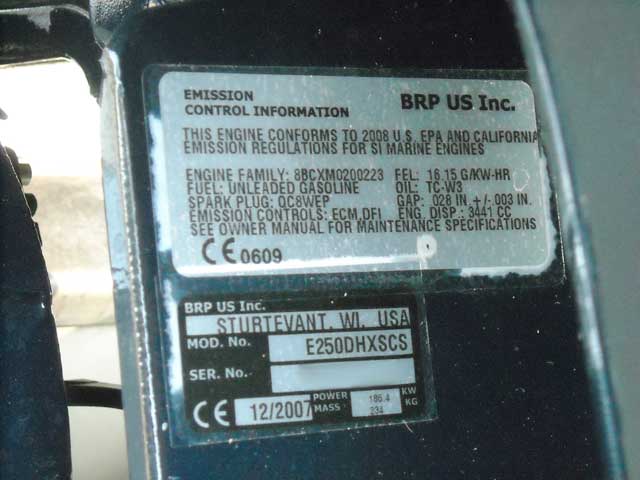 |
Emission Label
This required emission compliance label shows the engine power as 186.4 kW and the weight as 234 kG. That's 249.9-HP and 515-lbs in English units. These labels are often the best source of information about engine power output. The date of manufacture is also clearly shown. This engine is a 2008-model year product.
Photo Credit: JWH |
The Installation
A primary consideration in making these tests was the ease of installation of the new motor. It literally took only an hour or two to make the engine swap. The two engines use the same transom hole pattern. And the rigging is more or less identical, with the exception of a slight change in the connectors used in the main electrical harness. To overcome this a pre-fabricated and standard part adaptor harness was used. The re-rigging was very simple: disconnect all the cables, loosen four nuts, remove the old engine. Hang the new engine on the transom, tighten four nuts, re-install the cables, using the adaptor to link the main electrical harness. All of the existing equipment in the boat—the remote shift and throttle controls, the ignition wiring, the tachometer, the alarm annunciator, the temperature gauge, the water pressure gauge, the tilt-trim gauge, the voltmeter, the hour meter, and all the existing cables and wiring—remained as it was. No changes. Nada. Very fast and easy to re-rig.
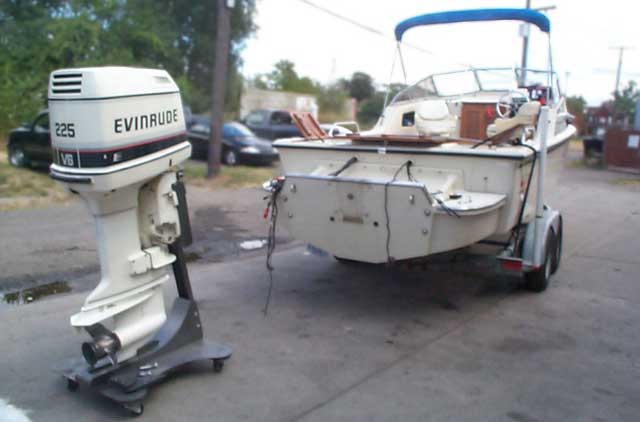 |
Off With the Old
The sixteen-year-old 1992 Evinrude 225-HP V6 motor was easily removed from the Whaler Drive. There were no frozen bolts or other problems.
Photo Credit: David Zammitt |
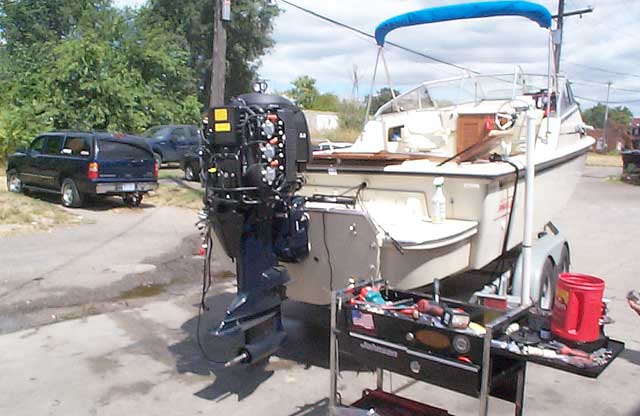 |
On With the New
The 2008 E-TEC 250 H.O. V6 motor bolted right back in the same mounting location. All rigging was re-used. A standard electrical harness adaptor cable mated the 16-year old boat rigging to the 2008 engine's connectors.
Photo Credit: David Zammitt |
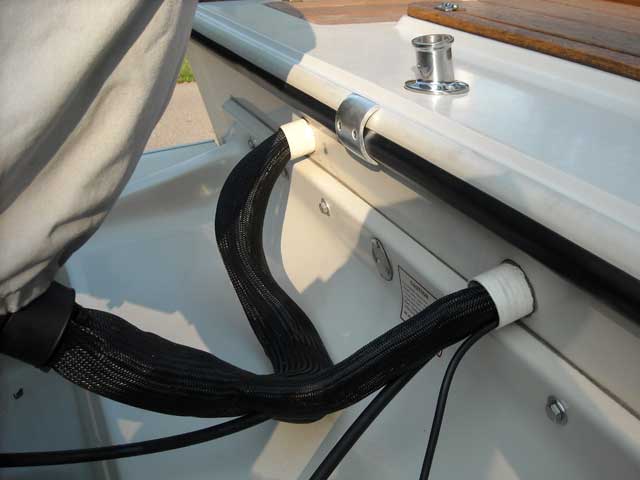 |
Rigging Details
The old motor had two bushings for rigging: on the starboard side the mechanical cables for throttle and shift, and on port the electrical harnesses and oil and fuel lines. The transom of the Boston Whaler was set up to match with twin rigging ports. The new E-TEC has a single bushing into the cowling. Douglas Zammitt solved that problem with this neat rigging.
Photo Credit: JWH |
The Initial Reactions
When I first saw the new motor rigged on my boat, I was somewhat shocked. The 250 H.O. was in the deep indigo blue color scheme, which made for a dramatic change from my old Ocean Pearl (off white) 225-HP motor. And the waving flag red-white-and-blue graphics were extremely bold, particularly compared to what now seemed the sedate graphics of my 1992 Evinrude. The new motor was somewhat larger and heavier, however its relative size was still very much in proportion to the rest of the boat. It did not look gargantuan, as some of the newer motors do when fitted on older boats designed for much smaller outboards. (As it turns out, the 250 H.O. in a 25-inch shaft is only available in the blue color scheme, so you don't get a choice with this particular power and shaft length combination.)
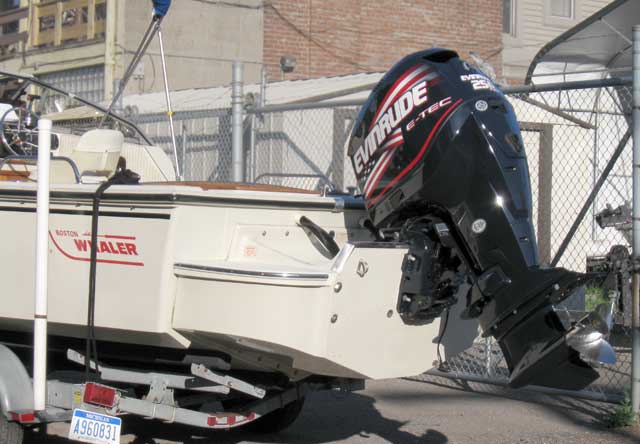 |
E-TEC on Whaler Drive
The E-TEC was still looking big and bold to me at this point. The deep indigo blue color scheme and bold flag graphics make this a very distinctive motor.
Photo Credit: David Zammitt |
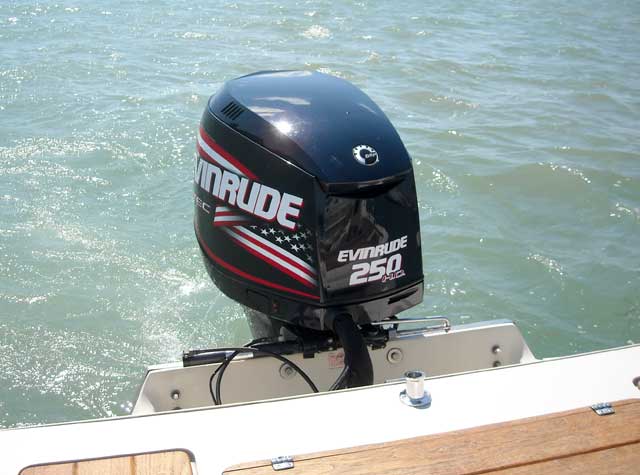 |
On the Water
Once we got on the water and tilted the engine down into operating position, the new color and graphics started to look quite at home on the transom.
Photo Credit: JWH |
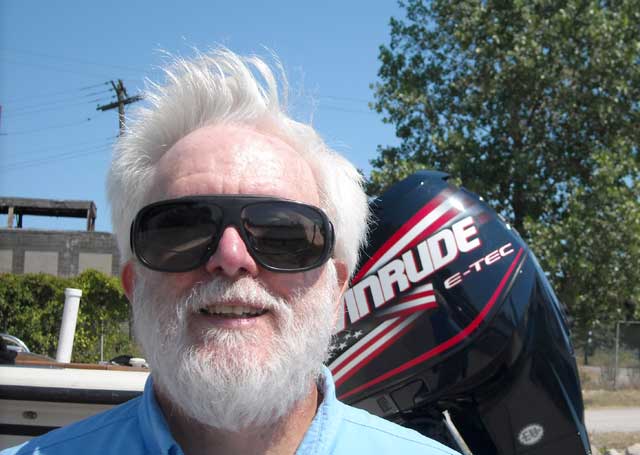 |
The E-TEC Smile
Here I am after the first test ride with the E-TEC. Dave says all his customers come back from the test ride looking like this: their hair all wind blown and a big smile. Dave calls it "The E-TEC Smile."
Photo Credit: Douglas Zammitt |
Start Up
Starting the 250 H.O. for the first time I noticed that it put more strain on the cranking battery than the old motor. I could hear an audible difference in the load on the battery. The E-TEC must be drawing more current to spin the flywheel than the old (and probably somewhat looser) 225-HP Evinrude. This new V6 must have higher compression. I am going to double check all the battery connections, including the main battery distribution switch wiring. Your cranking battery and primary battery distribution wiring have to be in top condition for these modern engines. An battery with a marine cranking ampere rating of 875 is the minimum needed to crank this big V6 motor.
When you turn the key to ON, the electric fuel pump runs to bring the fuel pressure up to specification on the fuel injector rail (but you can't hear this due to the sound absorption of the cowling). When you turn the key to START, the engine is cranked over, the engine management module typical fires the first spark plug before the end of the first crankcase revolution, and the engine immediately starts. There is no prolonged cranking. When it fires, it just runs quietly at idle speed. There is no smoke on start-up, or at any other time. And there does not seem to be much if any fast idle for warm-up. The E-TEC starts and it is ready to run. This simple start-up soon becomes second nature to the operator.
Once the E-TEC is running is has 50-amperes of battery charging current available. This can also be split with a dual battery charging accessory to permit two batteries to be charged independently.
Sound Signature
The E-TEC is much quieter than the older Evinrude. I did not have any equipment for taking sound level measurements, so all reports are by ear, but, trust me, the E-TEC is much quieter than the old carburetor V6 motor. All the higher frequency sounds are well muffled, and the note of the E-TEC is primarily a very low frequency fundamental tone. It hums, much like an electric motor, albeit a large electric motor. You can hear it running at idle, but you can also hear the splash of the confidence stream hitting the water. There is an ICOMIA standard on outboard engine noise (39.94), and the E-TEC's rating is 84.0-dBa.
The first time Chris and I launched the boat with the new E-TEC there was a lot of traffic at the four-lane ramp in Charlevoix. Also the lake was quite active and some boat wakes were rolling into the ramp area. Chris was busy holding our boat off the courtesy dock pilings while I jumped in to start the engine and prepared to leave the ramp area. I turned the key, and the E-TEC came to life. I took off the stern line and yelled to Chris to get ready to cast off the bow line. She turned to look at me with a puzzled expression. "Is that engine running," she asked, in complete sincerity. The sound of the E-TEC at idle was imperceptible to her from the dock.
Engine Mount Stiffness
When the E-TEC runs at idle (or other speeds) there is not a trace of motion or shake in the cowling. This is due in part to the smooth V6 design, but also to stiff engine mounts. The engine transmits some vibration to the boat. At first we noticed a rattle. We tried to locate the source, but it seemed to localize to things in the boat itself, not from the engine. I believe that the quieter engine has allowed us to hear noises in the boat which were always there but were previously masked by a louder engine. One rattle seemed to be coming from the remote throttle and shift controls. Perhaps some vibration was being conducted to them by their mechanical cables. We plan to try to chase down more of these new rattles in the boat to see if we can reduce them.
There has been speculation that the engine mounts on the H.O. models are different (and stiffer) than on the standard E-TEC models, however it appears (from some part listings) that the same components are used on all models. Stiffer engine mounts are often employed in applications where high speed is desired. In a recent series of articles in BASS & WALLEYE BOAT magazine which sought to improve performance of an older boat and motor, increasing the stiffness of the engine mounts contributed a significant improvement in boat speed.
The Speed
A primary indicator of performance is boat speed. In this regard the E-TEC 250 H.O. was very impressive. Just a month prior we had the boat in more or less the identical loading, with the same crew aboard and the same gear loaded. The only difference was one cooler with some spare clothing and gear, which probably weighed about 25-lbs. The new engine weighs at least 75-lbs more than the old, so for all intents the weight of the boat in both tests was the same, or, if anything, heavier in the E-TEC tests. With the 225-HP in July the top speed we could obtain was generally 38-MPH, which we might have been able to stretch to 39-MPH in the most favorable situations. With the new E-TEC we reached 46.5-MPH. This is an increase of 7.5 to 8.5-MPH, which is very impressive. Generally the speed of a boat varies with the horsepower-to-weight ratio change by a power of 0.5. Since we consider the boat weight to have been constant, the power change was in a ratio of 250/225 = 1.11. This implies the speed should change by 1.11^0.5 = 1.054. If the old motor reached 39-MPH, the new motor would be expected to reach 39 x 1.054 = 41-MPH. We hit 46.5-MPH, or much greater speed increase than would be predicted on the horsepower comparison.
The boat speed as a function of engine speed is shown in the graph below. The boat operates in two distinct modes: displacement and planing. We don't have any data to show between 1,500-RPM and 3,200-RPM because the boat just doesn't want to operate in that speed range. It will plow along in a wasteful bow-high above-displacement-speed mode which might only be useful in very unusual circumstances, such as having to make way against very large seas, but in normal operation we never run the boat in that manner. The E-TEC did add a new planing speed range, 18 to 20-MPH, where we could run and maintain decent fuel economy (2-MPG) at the same time. We could run around 22-MPH with the old motor but the fuel consumption was terrible, and we tried to avoid it.
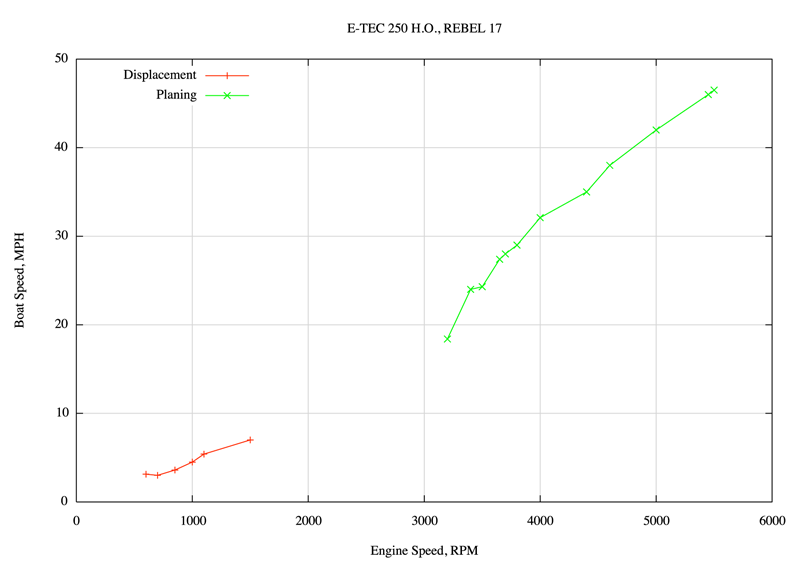
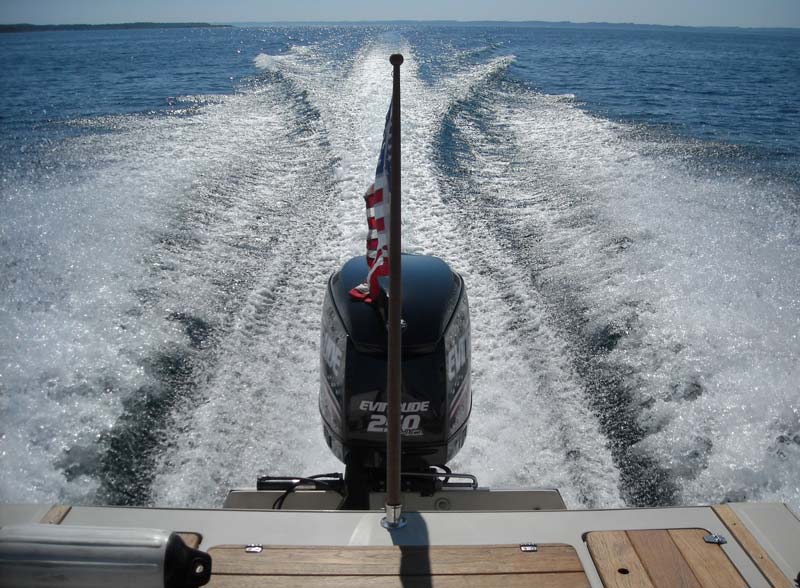 |
The Airy Wake
Inbound for Charlevoix off Lake Michigan on a beautiful summer afternoon, the E-TEC 250 H.O. looks quite nice on the Whaler Drive. We're cruising along above 25-MPH. The wake shows one of the considerations of propeller selection with a Whaler Drive boat: all the airy water coming out from under the drive. The E-TEC and REBEL motor-propeller combination produced a narrow wake, and the boat seemed to run with more stern lift than usual. Chris has done a nice job of holding a straight course line.
Photo Credit: JWH |
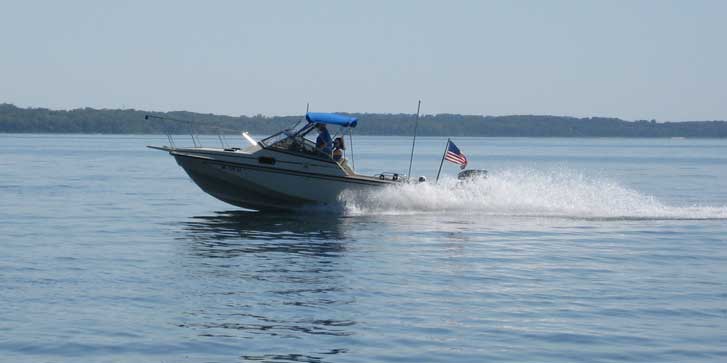 |
On Plane
With CONTINUOUSWAVE on plane at an angle of about seven degrees and throwing her usual spray, the motor is more or less hidden.
Photo Credit: David Buckalew |
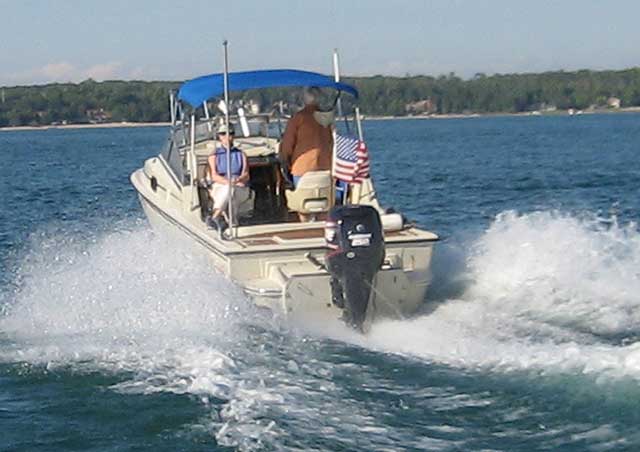 |
Engine Mounting Height
In this view we can see the spray deflector above the anti-ventilation plate is doing its job. Most of the spray is deflected outward. The anti-ventilation plate is not visible, but it appears as if it is running near the surface. I will have to get out on the Whaler Drive and take a few pictures next time we are underway to be sure. Doug Zammitt crawled out there on our initial test run and said the anti-ventilation plate was just barely breaking the surface. It sounds about right to me for a boat that has to run in some seas.
Photo Credit: David Buckalew |
The Fuel Consumption
As impressive as the speed figures were, the fuel consumption figures were also very favorable. In the month prior we had run several hundred miles on the boat and burned about 150-gallons of fuel. Our average miles-per-gallon for a 7-day cruise was 1.72-MPG. (During that time the boat was equipped with an Evinrude SST propeller, originally of 15-inch pitch but since reworked with greater cup on the blades. See below for more on the propeller influence in the test results.)
In three days with the new motor we burned 57.6 gallons of fuel and covered 151.5 miles. Our average miles-per-gallon was 2.63. This is an improvement of 0.91-MPG, or a 53-percent gain in fuel economy.
The improvement in fuel economy was most significant at lower speeds. At idle to about 1,500-RPM the old motor wasted fuel at prodigious rates, and it got only about 1.4 to 1.7 MPG, some of its worst numbers. In contrast, the E-TEC has spectacular fuel economy in this speed range. At about 1,000-RPM the E-TEC pushes the boat along at a nice no-wake speed of 5-MPH and gets 25-MPG, an amazing improvement--sixteen times better fuel economy. I better repeat that for emphasis: the boat gets 25-MPG at no-wake speed.
At higher speeds the E-TEC had better fuel economy than the old motor across the board, but the difference was not as spectacular. Most recently the old motor was just able to hit 2.0-MPG at its optimum cruise with the heavy loads were were carrying. With those same heavy loads the E-TEC produced an optimum of 2.65-MPG. This is a 32.5-percent improvement. Similar improvements were noted at all speeds. With the old motor, it was almost impossible to hit 2.0-MPG at any speed with this loading. With the E-TEC we hardly ever saw any reading below 2.0-MPG at any usual speed. Only running above 38-MPH would take the fuel economy below 2-MPG, as the graph below shows. You can also see the hull's favorite speed, about 28-MPH. That's the sweet spot for best fuel economy.
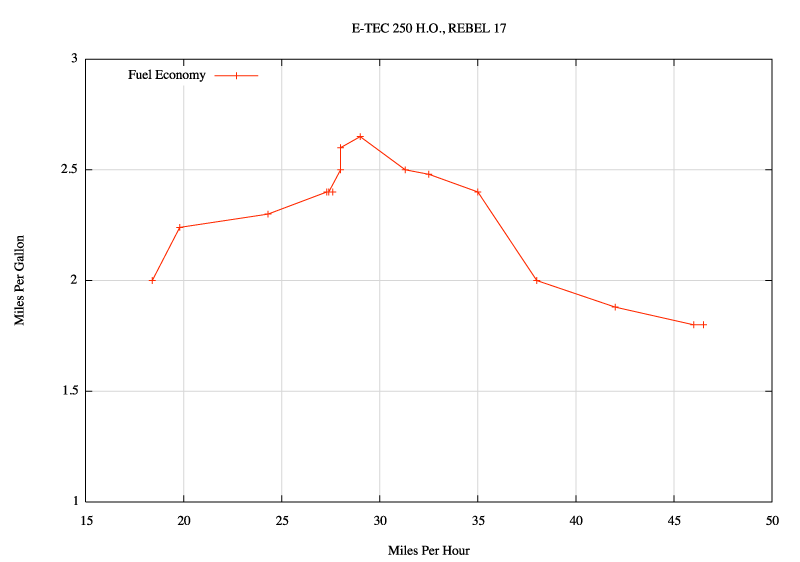
The improvement in fuel economy was anticipated, and the results were just as expected. At optimum cruising speed, the old two-cycle carburetor motor was running at its peak efficiency. The direct-injection motor surpassed it, but only by about 30-percent. Conversion of gasoline to propeller thrust is ultimately controlled by the laws of physics, and reports which cite fantastic improvements at optimum cruising speeds should be viewed with a critical eye to other factors influencing the outcome. With the old motor, fuel economy worsened at all speeds other than optimum cruise, and in particular at low speeds the fuel economy was often frustratingly bad. The direct-injection two-cycle E-TEC produced a sixteen-times improvement in fuel economy at low speeds, where its fuel burn was very significantly reduced.
The History Report
In testing the new E-TEC we thought we had "run that motor like we stole it" as the saying (from the beautiful E-TEC promotional film) goes, however, we were quite surprised to learn from the engine's own memory that the motor had spent the majority of its first 12-hours and 17-minutes of time running at idle speeds. A total of 54.8-percent of that time the engine was running below 1,600-RPM. We also thought we had pushed the throttle to the maximum quite a bit, more often than we normally would simply to see what speeds we could obtain. But it turned out we only spent about five and half minutes at WOT (which turned out to be 5,360-RPM, slightly lower than our analogue tachometer was indicating). That was less than 0.8-percent of the time. About 37-percent of our operating time was between 3,000 and 4,00-RPM, our usual cruising speed range.
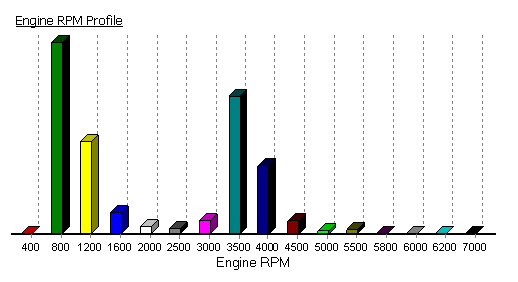 |
Engine RPM Profile
This graphic was produced by the Evinrude Diagnostic Software, version 3.0, which runs on a Windows laptop and makes a wired RS-232 serial connection to the Engine Management Module of the E-TEC. The engine reveals all sorts of data about itself using this software tool. |
The Instrumentation
When collecting test data the information is only significant if the instruments used to collect it are accurate. In this case, the precise same instrumentation has been used to collect all the data. The speed information comes from a GPS receiver. The fuel data comes from a fuel flow sensor. Both devices are completely independent of the engines being tested.
The GPS receiver is part of a Standard-Horizon chart plotter. The receiver is capable of receiving WAAS correction data, however during the test period it did not seem to always be in the WAAS mode. Loss of WAAS correction does introduce some error in position locating, but I do not believe that it introduces much error in speed measurements. In any case, speed data was collected on many trials and readings were averaged. There may be a small error, but it is very likely totally random and cannot influence the outcome in a significant or consistent manner.
The fuel flow sensor is part of a Navman 3100 Fuel instrument. I have been using this device for three years. I do not believe that it is absolutely accurate in its measurements. My observation is that the 3100 measures the fuel flow to be greater than it actually is. This is based on many tanks of gasoline consumed—over 1,000 gallons—where the actual level in the tank gradually becomes greater than the level computed by the 3100 from its sensor's measurement of fuel flow. Typically by the end of a season my fuel tank has about 30-gallons more fuel in it than the 3100 indicates. Since I usually consume about 300 to 500 gallons per season, it seems the flow sensor reading about 6 to 10-percent higher than actual.
In addition, the error in the 3100 fuel flow measurement appears to be increasing with age. This conclusion is based on the fuel flow measurements of the boat and motor over three years. According to the 3100 the boat's fuel economy has been gradually declining. My feeling is that there really has not been a change in the boat or motor, but instead there has been a change in the calibration of the 3100. As it gets older, its fuel sensor impeller seems to be spinning a little easier or faster than when new. However, I have intentionally avoided making any change in calibration to the device, particularly during the tests of these two motors, so as not to introduce any additional variable that would affect the results. Also, I have limited the comparison data between the two motors only to data recently obtained. Because of aging of the fuel flow sensor, it is not valid to use fuel flow data from two or three years ago for the comparison.
Therefore I offer the observation that the fuel flow data may not be absolutely accurate, and, if anything, it probably reports the fuel consumption to be greater than actual. This has the effect of causing the computed fuel economy figures in miles-per-gallon to be lower than the actual results. Please keep this in mind if you want to use this data to make a comparison to other tests: the MPG numbers are very likely lower than actual. Using my estimated error of 10-percent, this means the 2.6-MPG deduced here might actually be more like 2.85-MPG on average.
On the other hand, I believe the fuel flow data is consistent during the test period that spanned only a month or so. This makes the comparative data from the two motors valid. I strongly believe that the E-TEC motor gets better fuel economy than the carburetor motor, and by the percentages I have shown. In the case of the average fuel economy figures, these are computed based on measurements of over 50-gallons and 150-gallons of fuel flow. Going from 1.7-MPG average to 2.6-MPG average is the same cost reduction as lowering the price of fuel from $4-per-gallon to $2.60-per-gallon. There is a lot to like about those figures.
Because the exact same instruments were used to make all measurements, there is no potential for variation among the measurements due to instrumentation variation. In many comparative tests of motors the data is gathered by completely different instruments, or, even more questionably, by completely different measurement methods. In this comparison all data was obtained by the same instruments using the same methods.
Other Influences
It would be inappropriate to attribute all of the improvement in speed obtained with the new motor to the greater power of the engine itself. At least two other factors likely contributed: the propeller and the gear case.
Propeller Influences
The propeller used with the E-TEC 250 H.O. motor in these tests was an Evinrude REBEL three-blade with 17-inch pitch. This propeller is quite similar in size and design to the Mercury MIRAGEplus propeller that had been previously tested on the old motor. Indeed, in prior testing the fuel economy of the boat improved with the MIRAGEplus propeller compared to the SST 15 propeller used in making this comparison. However, it should not be inferred that the deck was stacked to get a favorable outcome. Experience has shown that the old engine could not operate with the MIRAGEplus 17-pitch propeller when loaded as heavily as was done in these tests. Further, the MIRAGEplus 17 was sensitive to trim settings and water conditions. The MIRAGEplus 17 would often lose grip or blow-out in heavy seas. In this regard it was not suitable for the conditions of the test. Data from prior tests with the MIRAGEplus was collected with different boat weights, so it is not completely comparable to the data from the E-TEC 250 H.O. testing.
The REBEL 17 performed extremely well during the tests. It never lost its bite or blew out. Since it is the only propeller tested with the E-TEC 250 H.O. in this comparison, there is no guarantee that it is the optimum choice, and it might very well be that a different propeller could produce even higher speeds or better fuel economy. However, my impression is that the REBEL 17 gave very good performance, and with the heavy load conditions of the test I doubt there is a great amount of unrealized gain in either boat speed or fuel economy to be had with another propeller.
If the E-TEC gets better fuel economy because it can turn a larger propeller, the credit has to go to the E-TEC, not the propeller. The old motor can't quite turn a larger propeller like the REBEL 17, and thus it can't get the better fuel economy the propeller offers.
Gear Case Influences
The 250 H.O. uses a different gear case than the standard E-TEC engines. The gear case has been designed for high-speed and higher engine mounting height applications. The cooling water inlets have a scoop design, and there is a Pitot tube inlet at the point of the gear case bullet for connecting to a speedometer. The gear reduction is also reduced to 0.58, or 1:72:1, from the usual 0.54 or 1.85:1 ratio. The high-speed gear case is called the "Lightning" gear case. It was recently redesigned and given a new designator, L2. The L2 gears are larger and machined from higher strength material in order to handle the tremendous torque output from the H.O. motor. The 250 H.O. develops almost 300-lb-ft of torque, and BRP has engineered the L2 gear case to handle it.
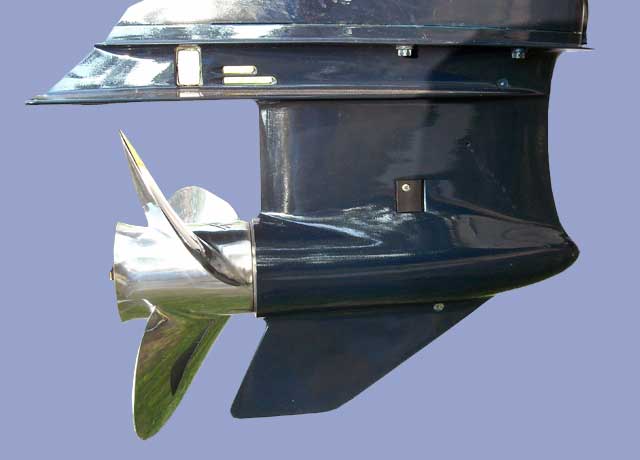 |
H.O. Gear Case
The H.O. series of E-TEC motors use the L2 or LIGHTNING gear case. The leading edge of the gear case is shaped completely differently than the usual straight edge of the standard gear case. The L2 uses new, larger, and stronger gears. The water inlet location is lowered. The propeller shown is a REBEL three-blade in 17-inch pitch.
Photo Credit: JWH |
The LIGHTNING or L2 gear case seemed to work well with the high engine mounting height of the Whaler Drive single engine installation. For example, the water pressure was noticeably higher with the 250 H.O. engine. My pressure gauge was usually against the pin at 15-PSI when running at speed, whereas with the older engine the pressure was more in the 10 to 12-PSI range. Since the L2 is really not designed for a twin-engine set up, it is not offered in a counter-rotation version.
When I began testing I believed that the propeller shaft position on the 250 H.O. was slightly lower than on the older motor relative to the transom mount. However, this turned out not to be true. The 225-HP V6 put the propeller shaft about 35.25-inches below the transom top surface, but the 250 H.O. with L2 gear case put the propeller shaft at 34.25-inches below the transom top surface. This was surprising. On the Whaler Drive installation, where I have always felt that the engine was running a bit higher than optimum, I was anticipating the L2 gear case might actually run a bit deeper. The approximate one-inch difference between them is equivalent to about "one-hole" (0.75-inch) in height, but the new motor never showed any sign of propeller blow out, even though it was running even higher than the old motor! Apparently the REBEL propeller can really hang on even in high mounting positions.
Even with the REBEL propeller running in what I would consider an elevated height, it showed decent SLIP numbers:
SPEED SLIP
MPH %
18.4 38.4
19.8 33.7
24.5 22.8
27.4 19.6
29 18.3
31 16.2
35 14.8
38 11.5
42 10.0
46.5 9.4
For a single engine installation, and on a large and heavy boat, having a SLIP percentage of around 10-percent at maximum speed is typical of a propeller that is working well in my experience. SLIP numbers are hard to compare among different propellers as they depend a great deal on the stated pitch. Propellers with an understated pitch or which have a lot of cup will produce low SLIP numbers.
Other Influences
Other factors may have influenced the results as well. The stiff engine mounting seemed to be advantageous. The weather was quite similar, however the water and air temperatures were colder in the test period of the old motor, which generally would tend to enhance its performance. The data from the old motor was collected with only one thing in mind: run at absolutely best fuel economy when possible. This was due to the very high price of gasoline at the time. Believe me, every effort was made to maximize fuel economy on that trip. On the other hand, the new motor was run at a very wide variety of speeds with the intention of gathering data, not optimizing fuel economy. Overall, I suspect the two tests were reasonably equivalent with respect to weather, temperature, and water conditions, and both engines were operated over a wide variety of speed ranges which represented typical cruising situations.
Data Acquisition
In collecting this data I observed that the boat's performance is quite sensitive to how it is driven. Small changes in weight distribution, engine trim, and wind or wave conditions can all affect performance, and especially the fuel economy readings. It was quite interesting to cruise along in relatively calm water with the engine set at a constant speed and make small adjustments in trim or weight distribution. The measured fuel economy would respond to all of these inputs. Tuning the engine trim for best fuel economy at a fixed engine speed was particularly useful. Generally you could alter the computed miles-per-gallon by plus or minus 0.1-MPG just by bumping the trim up or down slightly. Moving some weight around the boat could produce similar influences.
Observed fuel economy was also affected by the timing of the observation. The E-TEC, like most modern engines with fuel injection, has two fuel pumps. A lift pump brings fuel from the tank to the engine. A second pump raises the fuel line pressure and distributes the fuel to the injector rail. There is typically excess fuel in the system, which is returned to a reservoir where it is cooled and any aeration in the fuel separated. The action of these two pumps in series results in a somewhat uneven fuel flow from the tank to the engine. Since my fuel flow sensor is located in that portion of the fuel system, fuel flow measurements were affected.
If a fuel flow measurement was obtained immediately after the boat had been allowed to slow from a higher speed, the fuel flow at that point may not be representative of the actual flow rate. The extra fuel in the fuel system is consumed for a brief time before the lift pump begins to refill the reservoir. For example, if the boat were running at 30-MPH and the engine speed were reduced to give 25-MPH, it is necessary to let the boat run at the new lower speed for a moment or two in order to let the fuel flow become representative of the actual flow at that rate.
The 3100 Fuel Instrument has settings which permit the reading shown on the instrument to be damped by averaging the data over a longer time period. I had already adjusted my 3100 so that its displayed fuel economy calculations were based on a longer sample period than the default. Generally when collecting fuel economy data we let the boat run for at least 30-seconds until the displayed fuel economy figures settled into a constant reading or stayed in a narrow range before recording any data.
The effect of winds and waves could also be seen. The boat always went faster and got better fuel economy when going downwind and down-sea. I have tried to be aware of these variables and to remove their influence from the reported data. In summary, when performance data is collected and reported, there is room for variation in the results from influences in how the boat is being driven and when the data is collected. Test results could be influenced by these factors.
Unexpected Improvements
As we ran the boat with the E-TEC 250 H.O. for three days, we noticed many differences in the boat's handling and ride. First of all, the E-TEC 250 H.O. weighs a bit more than the old Evinrude 225-HP V6, and this put the static trim on the Boston Whaler REVENGE 22 W-T WD more down by the stern and higher in the bow. This static bow lift was actually appreciated, as getting the bow up on our boat has always been a bit of a challenge, especially when the cabin is filled with 150-lbs of cruising gear. The new motor and propeller also seemed to have much more effective control on the boat's trim. If we hit the trim switch to raise the bow, the bow would actually come up distinctly. Previously changes in engine trim did not seem to produce such clear response from the boat. In this regard I believe many would say this propeller has more "lift."
We also noticed that the boat seemed to handle better in waves. When going over a wave crest we would find ourselves anticipating a rough landing that never seemed to come. The bow would come down more gently than our experience with this boat for many years had trained us to expect. I attribute this behavior to two factors: the propeller and the direct-injection engine. I think the propeller has a strong grip and more lift, so it tends to hold the bow up better coming off a wave. Also, the direct-injection engine does not change its speed when the propeller load changes, and as a result, it maintains its speed up the wave. When you crest the wave the engine does not suddenly speed up as the load on it eases. The result is a gentler ride and softer landing.
On long runs on plane the considerable reduction in engine noise was very pleasant. In the past we have noted a certain acoustic fatigue from the roar of the engine when running at high speeds for an hour or more. With the E-TEC there is much less acoustic fatigue; the engine is quieter and its tone more pleasant as there are no harsh harmonics of the deep fundamental tone.
The E-TEC throttle response is quite different than that on our old carburetor motor. When you set an engine speed with the E-TEC, the engine runs at that speed. It does not hunt up or down in response to changes in its load from waves, nor does it drop speed in turns. When the throttle is set for the engine to run at, say, 3,800-RPM, the E-TEC is going to run at that speed. It seems to have almost unlimited reserve power, so when you begin to climb the back of a wave there is no engine speed drop. And, when you begin to come down the face of a wave, there is no corresponding engine speed increase.
The E-TEC also accelerates very rapidly. We found it necessary to alert the crew when we were going to push the throttle forward. It we didn't, the sudden acceleration often caught the crew off guard. The same situation applied to deceleration. If you yank the throttle back quickly, the engine speed drops very quickly. This can also send the crew flying if they're not prepared.
Perhaps the biggest unanticipated benefit of the E-TEC came from its ability to idle at 500-RPM. This low idle speed produced a correspondingly low boat speed, about 3-MPH. In docking situations the ability to maneuver at 3-MPH can be very helpful. Approaching a dock at 3-MPH can give the pilot more control in some circumstances than coming it at 5.5-MPH (the older motor's idle speed).
One afternoon we were coming back to our slip in the marina. Just as we were about to make a 90-degree turn from the main channel into the side channel of the marina, we were met by a large inboard diesel-powered charter boat coming out with a full head of steam, making about 6-MPH. We had to make a quick shift into reverse and put on plenty of throttle to back out of the path of the other boat. With the old motor this sort of maneuver would often result in the engine stalling when you came out of REVERSE at high throttle. From habit, as soon as I shifted out of REVERSE I looked at the tachometer to see if the engine were still running. Of course, the E-TEC was right there: 500-RPM idle. The charter boat captain hailed us with a "Thanks" for getting out of his way.
Finally, one benefit to having a very quiet motor at idle speeds is the ability to hear what people on other boats are saying as you go by. Most people don't seem to be aware of just how quiet the E-TEC motor is, and as you pass by them they don't realize you can overhear their reaction to it. Most often people commented on the bold flag graphics (and quite favorably, too).
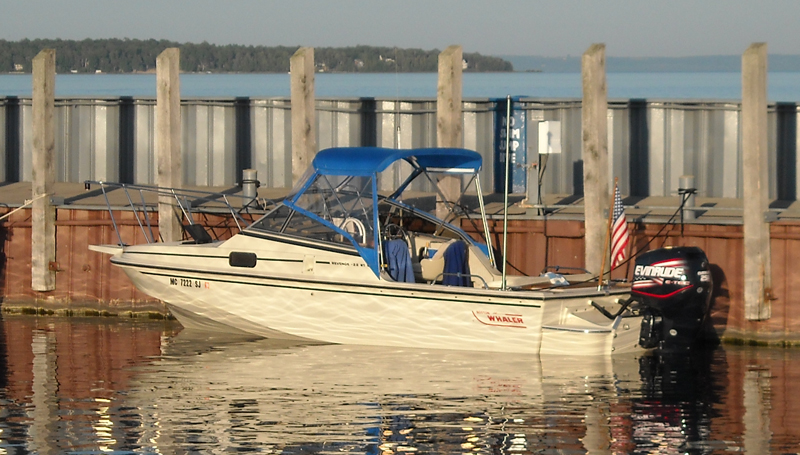 |
E-TEC on REVENGE 22 W-T WD
CONTINUOUSWAVE is moored on the sea wall at the Northport Marina in northern Michigan on a beautiful summer evening in late August. The overall proportions of the boat and motor are excellent. The E-TEC's greater weight has given the boat a new static trim. The bow is now a bit higher than previously seen, and we like the look.
Photo Credit: JWH |
Summary
The E-TEC 250 H.O. motor is a great replacement for the 1992 Evinrude 225-HP V6. Re-fitting the motor to the boat was quick and re-used all the existing rigging. The E-TEC is much faster and at the same time gets very significantly better fuel economy. The E-TEC runs much more quietly, and it idles down to 500-RPM when needed. The acceleration and power seems instantaneous and unlimited. It made the boat run and handle better.
Acknowledgments
The 2008 Evinrude E-TEC 250 H.O. motor used in these test was provided by Dave Zammitt of Lockeman's Hardware and Boat in Detroit. David is the one who came up with the idea of testing the E-TEC head-to-head against an older Evinrude V6 motor. Because of the amount of data about performance and fuel consumption that I had already collected for my Boston Whaler, David though it would be an ideal test boat for the comparison.
The removal of my motor and the expert installation of the E-TEC 250 H.O. was provided by Douglas Zammitt of Lockeman's Hardware and Boat in Detroit. Doug did a great job of fitting the big E-TEC to the Whaler Drive. He thinks we ought to move it up one hole and shoot for more speed!
Comments or Questions
If you have a comment or question about this article, please post it in
the message thread reserved for this purpose in the Whaler Forum.
Addendum
The maximum power output from the 250 H.O. is believed to about 270-HP, and the peak occurs around 5,500-RPM. This curve is believed to be typical for the motor:
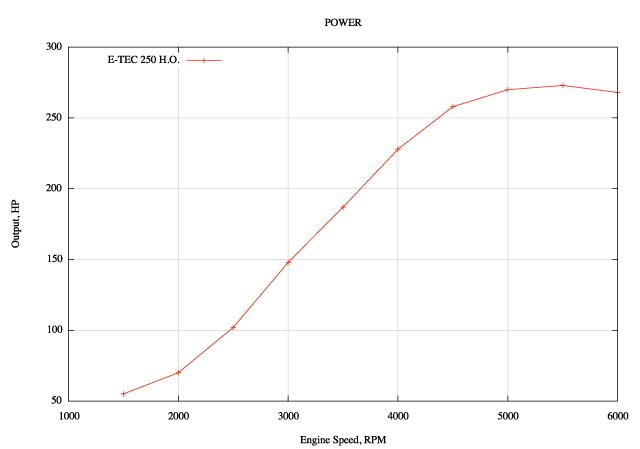
Maximum torque output from the 250 H.O. is believed to be about 290-LB-FT, and the peak occurs around 4,500-RPM. This curve is believed to be typical for the motor:
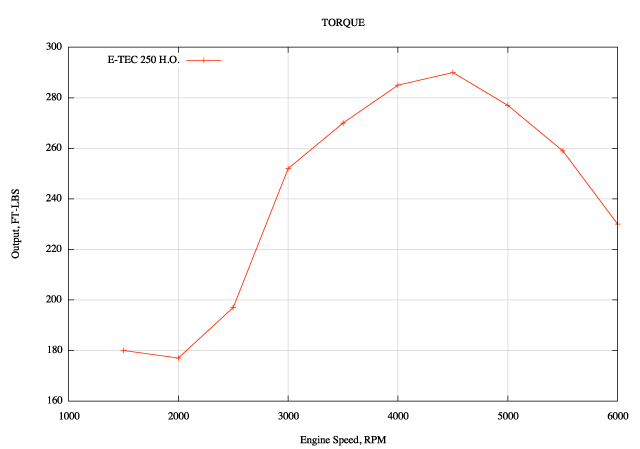
Rigging
My 1992 engine installation had been updated from its original configuration by the installation of an SYSTEM CHECK gauge a few years ago. This update added to the 1992 rigging a new wiring harness which was ultimately used in the E-TEC rigging. If a stock 1992 engine harness had still been on my boat, further modifications to the rigging would have been necessary to adapt it to the E-TEC. The E-TEC installation requires at least a SYSTEM CHECK gauge.
More Propeller Testing
CYCLONE TBX 17
A few weeks after the long weekend of testing the 250 H.O. reported above, I had an opportunity to try a different propeller with the boat and engine, a BRP CYCLONE TBX 17-pitch and 14.25-inch diameter. The CYCLONE TBX is a four-blade propeller that features the recently introduced TBX field-replaceable hub kit. It is described by BRP as being designed for "cruising and transom lift." These attributes made themselves known in the testing, as I explain further.
This initial data from the propeller testing is the boat speed as a function of engine speed. I show this below in a graph which also plots the same function for the REBEL propeller used in the initial testing. The results are generally comparable, but I should disclose that the boat weight was reduced slightly during the CYCLONE TBX testing. Approximately 100-lbs of gear was removed from the cabin of the boat. Also, the boat's canvas was not erected, so the wind resistance was somewhat less. The water temperature was the same, roughly 70°F, but the air temperature was cooler, in the mid-70's compared to 80-degrees and higher in the initial test. These factors will all tend to favor the CYCLONE TBX results slightly.
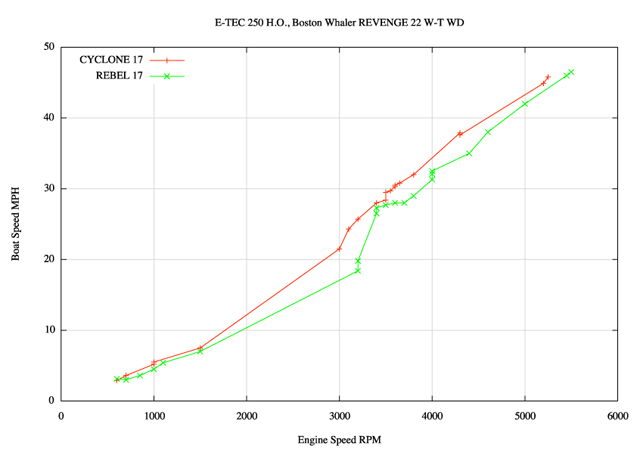
As the graphed data shows, the top speed of the CYCLONE TBX 17 propeller was about 0.7 to 1.5-MPH slower than the REBEL 17 propeller. This is not totally surprising because in general four-blade propellers do not produce as much ultimate top speed as three-blade propellers. In this case the difference is not particularly significant. Next we turn to the fuel economy of the CYCLONE TBX 17. This graph shows the performance in the vital cruising speed range.
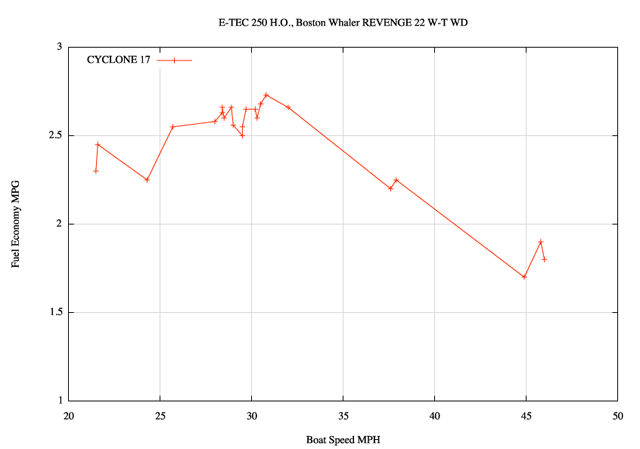
In observing this data plot, keep in mind that the old motor was only able to reach a maximum of 2.1-MPG, and even then this was only in a vary narrow speed range around 27 to 28-MPH, the optimum cruising speed. Most of the time it was below 2.0-MPG. In contrast, the CYCLONE TBX 17 produced a broad range of speeds with very good fuel economy above 2.5-MPG. The peak fuel economy seen was 2.7-MPG, and in this case the peak was somewhat faster, around 30 to 31-MPH.
The CYCLONE TBX propeller that was used was part of a new program from BRP of test propellers, and again our local dealer, Lockeman's Hardware and Boat, was very generous in making the propeller available. Lockeman's has just received a large inventory of new test propellers to allow them and their customers to try out a wide range of new BRP propellers on customers' boats. We literally unsealed the shipping carton on this particular propeller, so it was in perfect condition. To help identify the test propellers they have all been powder-coated with a bright yellow.
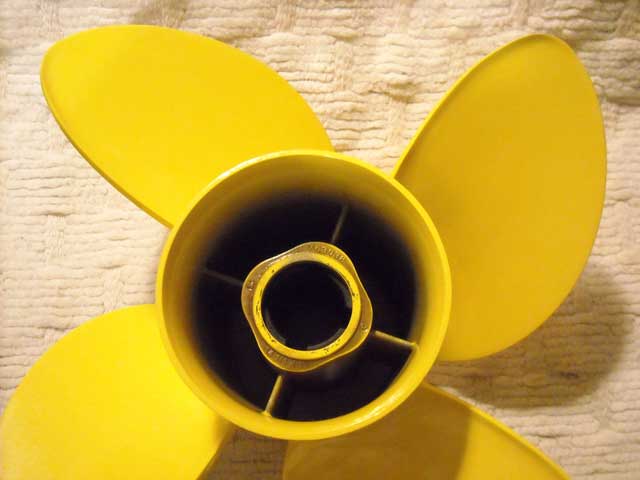
The photograph above shows the significant amount of cup added to the trailing edge of the blade (visible in the shadowed lighting on the upper right blade). The dark areas in the hub are not exhaust soot, as I explain below. Next I show the CYCLONE TBX propeller from the side.
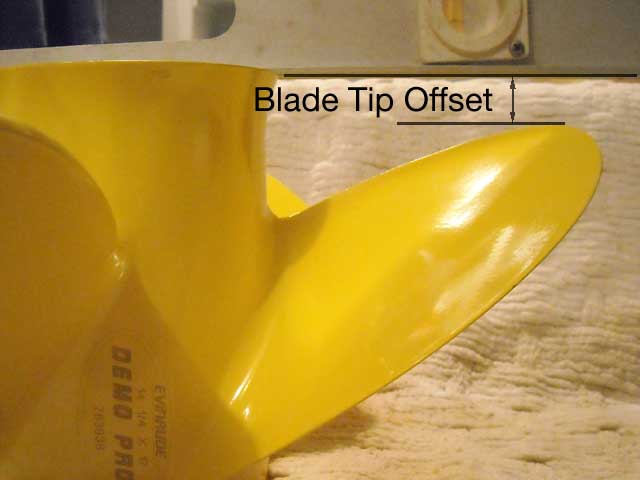
This angle shows the rake of the blades. There is moderate aft rake, but the blade tips do not project beyond the exhaust tube of the hub. Among BRP propellers this charactieristic is generally indicative of a propeller which has been designed to produce stern lift or transom lift. The exhaust tube is also slightly flared outward. This is also indicative of a transom lift or stern lift propeller from BRP.
We ran this propeller in relatively calm water. In most cases the only waves were our own boat wake. This was remarkable in that the boat wake was noticeably smaller than usual. A smaller wake is indicative of less of the v-hull in the water, and this is likely a result of the transom lift characteristics of the CYCLONE TBX propeller. Correspondingly, adjustments of engine trim did not seem to product the very marked response in bow trim that were noted with the REBEL. Trimming the motor out did produce bow lift, but it was not distinctive or sharp with the CYCLONE TBX. The force employed to generate the stern lift must come at the expense of thrust pushing the boat forward, so in the end we see (as expected) a lower top speed. The influence of the higher stern lift could not be fully appreciated in the calm water conditions we were running in.
The CYCLONE TBX produced very strong acceleration, and the boat came onto plane very rapidly, although no data was collected about the times needed. The propeller also maintained a solid grip, and there was no sign of blow-out even in the tightest of turns when the boat heeled far over.
The CYCLONE TBX uses the TBX field-replaceable hub kit. A plastic coupling inserts into the hub in a very tight press fit, engaging it firmly. A long anodized steel coupler connects the plastic coupler to the drive shaft. It has been my experience that some of these field-replaceable propeller hubs produce shifts with noticeably KLUNKs, but the TBX displayed none of that. It seemed to shift as smoothly and quietly as the rubber-hubbed REBEL previously tested. There were no signs of any vibrations, rattles, or other noises or artifacts of the TBX coupling.
The CYCLONE TBX 17 held the engine speed down to 5,200-RPM at wide open throttle. This was a bit of a surprise. Although the CYCLONE has four blades and the same 17-inch pitch, its diameter is 14.25-inches, or 1.25 smaller than the 17-inch pitch and 15.5-inch diameter REBEL. The engine reached about 5,600-RPM with the REBEL, and I was anticipating that the motor might be able to turn this four-blade to the same speed or even higher. (Here I refer to the readings indicated on my analogue tachometer, which, as I discovered following the first test, were about 200-RPM higher than actual, according to the engine's EMM.)
Regarding the lower wide-open speed, after we finished testing I removed the propeller from the motor and began to pack it up for return to Lockeman's. The engine exhaust passes through the propeller hub, so I used a paper towel and some cleaner solvent to wide off any residue. Even though we had run the engine for over a hour, there was not a trace of soot or exhaust residue on the propeller. The white paper towel came out of the hub without any black soot on it! This is an indication of how clean the exhaust gases from a THREE-STAR Ultra-Low emission two-cycle engine can be.
Our test time with the CYCLONE TBX so far has been only about one hour, and we were on a small lake where we could not let the boat run for long distances. This may have prevented us from dialing in the optimum results at some throttle settings. In testing propellers I have become aware of how influential the boat trim can be on results, both the speed and the fuel economy. It take some time to find the optimum settings for all speeds. Overall the CYCLONE TBX was impressive for its broad range of good fuel economy and for the general lift it gave the stern of the boat. I suspect that it might produce higher speeds if the engine were raised one more hole, however, I do not plan to investigate that in the immediate future.
SST 15
In the initial setting of this test it was important to make a comparison between the engines using the same test conditions, the same boat, and the same measuring equipment, with only the engine changing. Unfortunately we strayed slightly from that methodology by using a different propeller. This led some to speculate that perhaps the improvements noted were partially due to the propeller differences, as well as the engine differences. Since it was awkward to put the old engine back on the boat and re-test it with a new propeller, we did the next best thing: we put the old propeller back on the boat and tested it with the new engine. The results were somewhat surprising.
The "old" propeller is a well-used OMC SST 15-inch pitch three-blade. This propeller appears to have been modified slightly by the addition of some extra cup to the blades. Because of the added cup, I would say this propeller behaves more like a "16" pitch. Over four seasons of use it has become my favorite propeller to use when the boat is heavily loaded and will be in rough water. It has the best grip of any of the propellers in my inventory, and it gives a good account of itself in terms of performance. Its low pitch tends to bring the fuel economy down, and that is its only drawback.
I put the SST 15 on the E-TEC 250 H.O. and tested it during a long day of boating, where we ran about 60 miles in a variety of conditions. The boat was in the "light" configuration, as it was for the CYCLONE 17 test, and this was aided even more by the absence of any crew. So the results for the SST 15 have to be viewed with a bit of an advantage for them in terms of the total boat weight. It was probably at least 250-lbs lighter than in the original REBEL 17 test. We also ran with the canvas down, cutting air resistance as well.
As expected, the E-TEC 250 H.O. could really turn the SST 15 propeller, and it spun it all the way to 6,000-RPM. In this regard alone, the test was worthwhile--I finally got to hear the sound of the big motor running at its upper engine speed limit. There might have been a little more engine speed possible, but I did not want to push the throttle all the way to the wall, trim the motor to maximum, and let the speed build--it was darn fast as it was! What came as a surprise was how well the propeller performed. It hit 46-MPH on the GPS, but that was while running with some current in the St. Claire River delta around Harsen's Island. So I subtracted 1-MPH as a current boost, and recorded the speed at 45-MPH. This is a reasonable estimate, and it is based on the location at the time relative to the main flow of the river. We were far down a secondary tributary and not in the main stream. The adjustment also correlated very well with other data taken in that portion of the cruise when compared to data taken in the main lake, where no current was assumed.
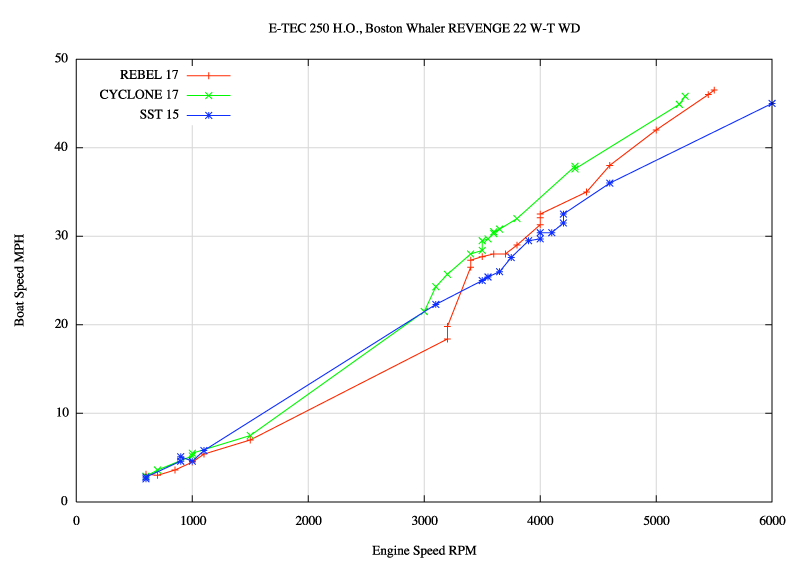
The chart shows the performance of all three propellers in terms of the boat speed produced at various engine speeds. The general slope the curves is indicative of their relative pitch.
It was expected that due to the lower pitch the speed would be down at various engine speeds compared to the two other propellers (whose pitch was 17-inches). There is a general thinking that a lower pitch will negatively influence fuel economy. This is based on the concept that when the engine turns a particular speed it uses a fixed amount of fuel. The engine speed is translated to boat speed via the propeller, and thus a lower pitch gives lower boat speed. Lower boat at a given engine speed should mean less fuel economy, assuming the fuel burn is constant. However, consider that the lower-pitched propeller is easier for the engine to turn, so at a particular engine speed less horsepower will be need to turn the lower-pitched propeller than a higher pitched propeller. This is one of the reasons we compare fuel economy only as a function of boat speed. Moving the boat at a particular speed should require the same horsepower, and only the propeller efficiency should be an influence.
The results obtained for fuel economy were surprising. The old SST 15 delivered very good numbers. Over 59.8-miles of boating with this propeller the fuel consumed was 23.8-gallons. That is an average of 2.51-MPG. Recall that with this propeller on the old 225-HP V6 motor, we averaged 1.72-MPG on our most recent cruise. The fuel economy improved by 0.79-MPG, or a 46-percent improvement. Here is a plot comparing all three propellers in terms of fuel economy versus boat speed:
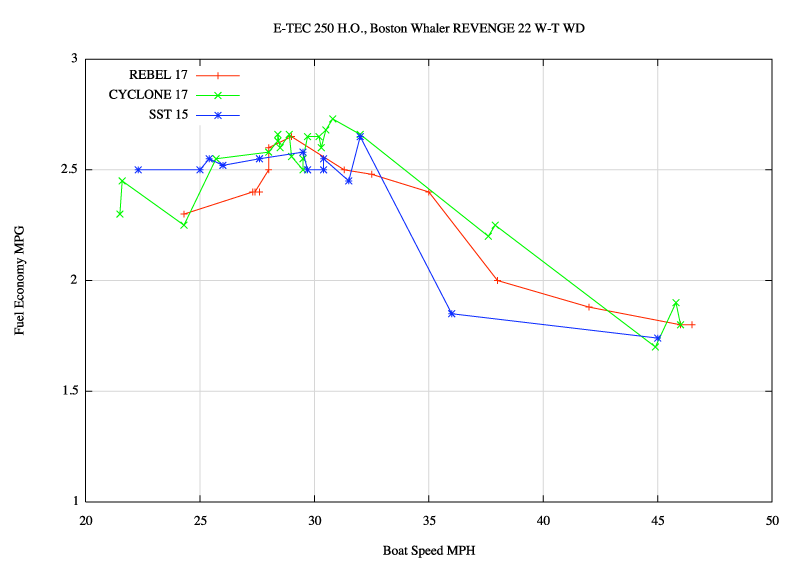
The lower-pitch propeller seems to delivery quite good fuel economy at the mid-range cruising speeds. It is only when you push the boat above 30-MPH that it really starts to suffer in comparison. There is quite a range of speeds in the desirable 25- to 30-MPH cruising range where the old SST 15 can just about keep up with its newer cousins from Evinrude.
Observations
Long term observation of the fuel economy of my boat with its original 225-HP V6 motor show 3,230-miles travelled and 1,793-gallons burned. This is a long term average of 1.8-MPG. As I noted, the measured MPG has been slowly declining, which I attribute to measurement error in the fuel flow meter as it has aged. The most recent average fuel economy for the old motor is 1.72-MPG, which is still in good agreement with the historical average. In comparison, the E-TEC motor has produced significantly better average fuel economy, at least 2.51-MPG and as high as 2.63-MPG.
With fuel prices at record high levels, there is a tendency to focus on fuel economy as the most important aspect of boat operation. However, improved fuel economy is not the only measure by which a new engine ought to be evaluated. A modern two-cycle motor like the E-TEC delivers many additional advantages, beside just better fuel economy. These additional factors should also be weighed when considering re-fitting an existing motor.
Data about the fuel consumption of the 225-HP V6 motor and SST 15 propeller are taken from my Sail Log for that trip. Long term data on the fuel economy and performance of many different propellers used on the boat with the 225-HP V6 has been previously been published in the REFERENCE section.
I-Command
About a month after the initial period of testing of the E-TEC 250 H.O., I fitted the motor with a digital instrumentation system using the Evinrude I-Command gauges. The I-Command instrumentation allowed for measurement of many parameters, including engine speed, engine temperature, and fuel flow rate.
The installation of the I-Command instrumentation was very simple. I-Command uses NMEA-2000 networking and the standard Device Net connectors, network Tee's, and pre-assembled cabling. The only unique component of the system was the drop cable for the engine itself, which has a four-pin connector for attachment to the engine wiring harness which is not a Device Net connector. The network backbone wiring consisted only of four T-connectors and two 120-ohm terminations, and it was located adjacent to the instruments themselves. Two I-Command gauges were connected using their integral drop cables, a power connection was made using a fused power cable and connector, and the engine was attached using a long drop cable to the stern. The installation took literally only a few minutes to accomplish. The most difficult procedure was connecting the power cable to the switched ignition circuit; this was done by temporarily borrowing the circuit which fed the mechanical hour meter. The gauges were mounted to a small panel which fit nicely in a side pocket at the helm station.
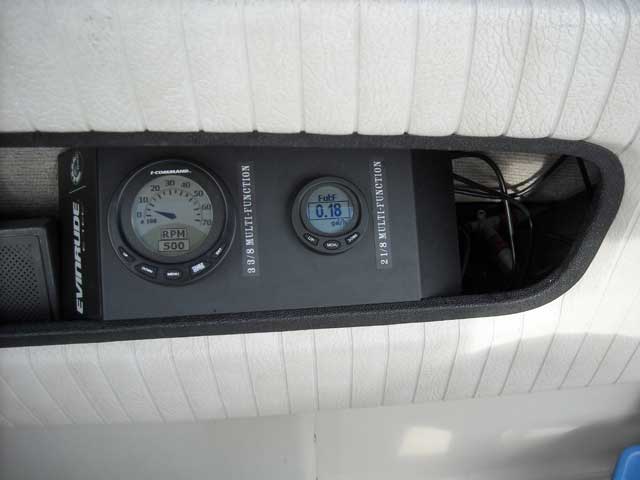
Prior to installation on the boat, I set up the I-Command gauges and a network backbone on my test bench. This allowed me to become familiar with their operation, and I quickly learned how to program them to display the particular data values of interest: engine speed, engine temperature, and fuel flow.
Variance in Data
The measurements from the I-Command gauges were generally in disagreement with the existing instrumentation on my boat. Compared to the traditional analogue gauges, on the I-Command the engine speed was shown lower, the engine temperature was shown higher, and the fuel flow rate was shown both higher and lower. We can briefly explore these differences.
Engine Speed
The I-Command shows the engine speed directly from the values used by the engine management module (EMM) which is controlling the operation of the engine, so it is believed that this data is absolutely accurate. Engine speed is shown only in increments of 50-RPM, and occasionally the reading would flicker between two values. The trend observed was that the I-Command engine speed was lower than the engine speed shown on the traditional tachometer. At idle the variation was about 150-RPM, and as engine speed increased the difference increased to several hundred RPM. Since all of our data about fuel economy is based on boat speed (measured consistently with the same GPS receiver), the only measurement influenced by this variation in engine speed is the propeller SLIP calculation. With the actual engine speed trending lower, this means all the propellers were operating more efficiently than previously calculated.
By the way, we did manage to let the big E-TEC spin up to 5,450-RPM with the REBEL 17 propeller at 97-percent throttle. This is just on the fringe of the recommended optimum engine speed range, 5,500-RPM. The REBEL 17 appears to be a suitable propeller for this engine and boat combination.
Engine Temperature
The engine temperature values were quite divergent from the existing temperature gauge. This is probably due to a difference in the measuring point. The existing temperature gauge sensor is located at the top of the starboard cylinder bank and threads into a boss in the engine block there. I do not know where the I-Command temperature is measured. The I-Command temperature trended about 40-degrees-F higher. When operating at cruising speed, for example, the analogue gauge would show the engine temperature about 100-degrees-F or less, and the I-Command would show it around 140-degrees-F. At slow speed operation the analogue gauge would rise to 140-degrees-F and the I-Command to about 175-degrees-F.
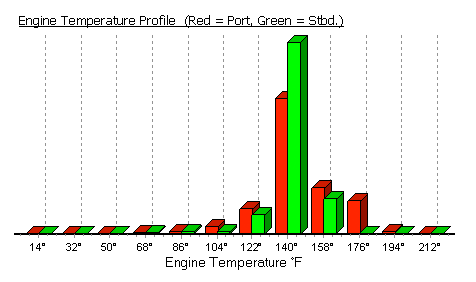
Fuel Flow
The fuel flow rate shown on the I-Command is the result of a calculation performed in the EMM and not the direct measurement of fuel flow by a transducer. The EMM knows the precise amount of fuel that each injector pulse delivers at every throttle setting--this is the basis for the operation of the whole E-TEC system. If these small fuel volumes are accumulated over time, the EMM can compute the fuel flow rate in gallons per hour. This technique should be very accurate.
Compared to the Navman fuel sensor, the I-Command fuel data tended to show a higher fuel flow at low rates and a lower fuel flow at high rates. At engine speeds near idle and up to about 1,000-RPM, the Navman would typically show a fuel flow of 0.2-GPH. The I-Command often showed a higher rate, typically around 0.3-GPH when off idle. The variation is only 0.1-GPH, but because of the low rate this is a 50-percent error. As a result, the fuel economy computed for the E-TEC is overstated by the Navman at low speeds. With the I-Command the 25-MPG fuel economy previously measured at optimum slow speed operation was reduced to about 16-MPG.
At engine speeds above 3,000-RPM, the I-Command showed fuel flow rates of at least 1-GPH less than the Navman, with the difference typically about ten percent lower. As a result, the fuel economy was similarly improved, and the peak fuel economy was now as high as 3.1-MPG where before only 2.6-MPG could be seen.
The variation in fuel flow measurement is consistent with the nature of the devices. In the Navman fuel flow transducer a mechanically spinning sensor is used. There is likely some inertia and resistance which causes the moving element of the transducer to tend to spin lower than the actual flow at very low rates. At higher flow rates the transducer appears to be just out of calibration, which again is consistent with its age. After 1,800-gallons of gasoline have passed through it, the transducer may now be spinning more freely than when new. It definitely needs re-calibration.
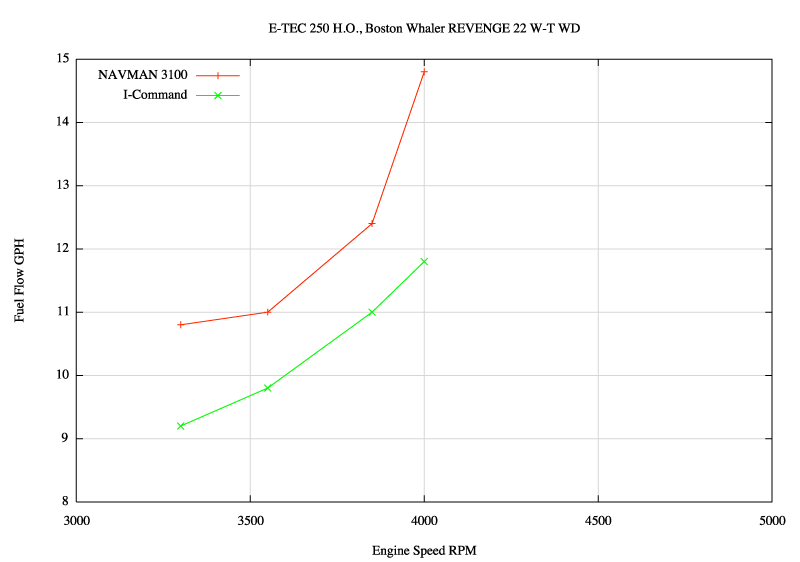
The graph above shows the general relationship between the fuel flow data measured by the two instruments. Again, the Navman consistently shows the flow rate at least ten-percent higher than the I-Command.
Fuel Economy
Fuel economy is computed by flow rate and boat speed. An error in either measurement influences the result. The boat speed is measured by a GPS receiver, and in all cases the same receiver was used. The receiver generally was tracking at least six satellites, so there is not much concern for an error. The fuel flow rate measurements are significantly different, leading to significant difference in the calculated miles-per-gallon fuel economy. Using the data from the I-Command, I re-calculated the MPG for the E-TEC as function of boat speed and plotted it against the data previously measured with the Navman for this propeller:
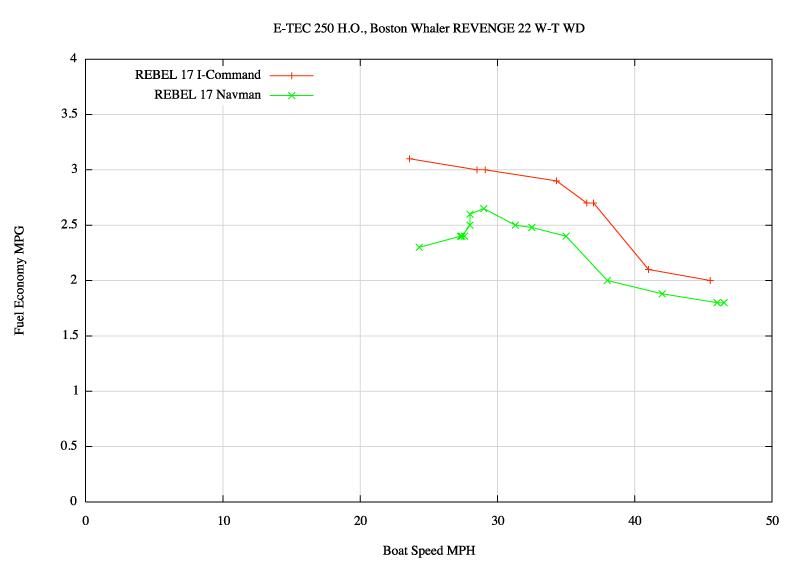
The new measurements show a significant improvement in fuel economy. Again, there are some environmental variations in the test conditions which may have influenced the outcome, as well as some minor changes in the boat set-up. The new data was collected with cooler air and water temperatures. The boat weight was slightly less, however we had lots of canvas rigged, which increases air resistance.
Final Remarks
I am afraid the testing will likely come to and end, due to the declining weather here in Michigan. This last weekend the overnight low temperatures were below 32-degrees-F, and daytime high temperatures were stuck in the 50 to 60 degree range. We're not prepared for really cold weather testing.
Since our boat does not have a lot of fixed costs when not being operated, the cost of fuel is the major cost of using the boat. With the extreme increase in fuel prices this summer, the cost of fuel has practically doubled, and therefore the cost of our boating has practically doubled. There is a psychological barrier to overcome when you begin to consider the expense of moving the boat on a per mile basis. Even though I fortunately can afford to do it either way, I find it is more pleasant to cruise along at 3-MPG than to cruise at 2-MPG, and the greater fuel economy of the E-TEC motor adds significantly to our boating pleasure. We have also become spoiled by the E-TEC motor's immediate starting, its smooth idle, its practically unlimited power, its lack of smoke and pollutants in its emissions, and its quieter running. As a friend observed, it is going to be much harder to take the E-TEC off our transom than it was to put it on.
DISCLAIMER: This information is believed to be accurate but there is no
guarantee. We do our best!
The page has been accessed times.
Copyright © 2008 by James W. Hebert. Unauthorized reproduction prohibited!
This is a verified HTML 4.0 document served to you from continuousWave
URI: http://continuouswave.com
Last modified:
Author: James W. Hebert
This article first appeared September, 2008.


























